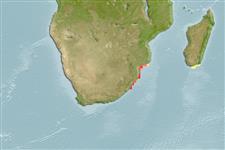Environment: milieu / climate zone / depth range / distribution range
Οικολογία
Θαλασσινό(ά); Γλυκού νερού; Υφάλμυρο βενθικό(ς); αμφίδρομο (Ref. 46888); εύρος βάθους 1 - 16 m (Ref. 28077). Subtropical; 25°S - 31°S
Africa: coastal lakes and estuaries in KwaZulu-Natal, South Africa, and southern Mozambique (Ref. 2798, 52193); also recorded from Madagascar (Ref. 4343).
Length at first maturity / Μέγεθος / Βάρος / Age
Maturity: Lm 3.0 range ? - ? cm
Max length : 6.4 cm TL αρσενικό/απροσδιόριστο; (Ref. 52193)
Short description
Κλείδες προσδιορισμού | Μορφολογία | Μορφομετρία
Ραχιαίες άκανθες (συνολικά) : 6; Μαλακές ραχιαίες ακτίνες (συνολικά) : 11 - 12; Εδρικές άκανθες: 0; Μαλακές εδρικές ακτίνες: 12.
Lives in burrows excavated in clean sand, often in association with the sandprawn Callianassa kraussi (Ref. 52193). Restricted to sandy, quiet water areas and is unable to form burrows where the substrate is disturbed by water movements, is muddy or consists of sand with a particle diameter > 0.5 mm (Ref. 28077). Food consists of slow moving benthic organisms like chironomid larvae, gastropods, bivalves and amphipods (Ref. 28077). Breeds throughout summer, males are territorial (Ref. 52193). On exposed shores, they occur deeper than 3.5 m (Ref. 28077, 2798). Occasionally intertidal.
Life cycle and mating behavior
Maturities | Αναπαραγωγή | Spawnings | Egg(s) | Fecundities | Προνύμφες
Skelton, P.H., 2001. A complete guide to the freshwater fishes of southern Africa. Cape Town (South Africa): Struik Publishers, 395 p. (Ref. 52193)
IUCN Red List Status (Ref. 130435)
Threat to humans
Harmless
Human uses
Εργαλεία
Special reports
Download XML
Διαδικτυακές πηγές
Estimates based on models
Preferred temperature (Ref.
123201): 23.6 - 25.1, mean 24.9 °C (based on 35 cells).
Phylogenetic diversity index (Ref.
82804): PD
50 = 1.0000 [Uniqueness, from 0.5 = low to 2.0 = high].
Bayesian length-weight: a=0.00708 (0.00333 - 0.01504), b=3.09 (2.92 - 3.26), in cm total length, based on LWR estimates for this (Sub)family-body shape (Ref.
93245).
Τροφικό Επίπεδο (Ref.
69278): 3.3 ±0.45 se; based on food items.
Ελαστικότητα (Ref.
120179): Υψηλό, ελάχιστος χρόνος για διπλασιασμό πληθυσμού < 15 μήνες (Preliminary K or Fecundity.).
Fishing Vulnerability (Ref.
59153): Low vulnerability (10 of 100).
